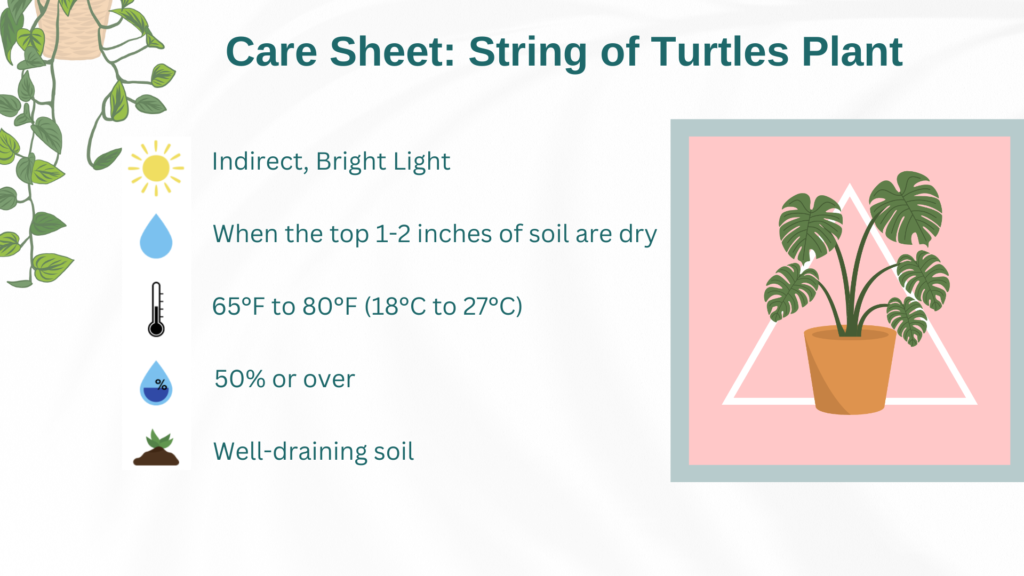If you’re looking for a unique and charming houseplant to add to your collection, the String of Turtles is a perfect choice. Scientifically known as Peperomia prostrata, this trailing plant is loved for its adorable, turtle-shell patterned leaves that cascade beautifully from hanging baskets or pots. It’s compact, easygoing, and an excellent plant for both beginners and seasoned plant enthusiasts.
The name “String of Turtles” comes from the round, patterned leaves that resemble tiny turtle shells strung together along its delicate vines. It’s not just a plant; it’s a statement piece for any indoor jungle.
How to Identify a String of Turtles
The String of Turtles has small, round leaves that are green with intricate white or light green veining, mimicking the appearance of a turtle shell. The leaves grow along thin, delicate stems that trail over the edges of pots or hang gracefully in baskets. It’s part of the Peperomia family, so it shares the characteristic thick, semi-succulent leaves.
Size
The String of Turtles is a small, slow-growing plant.
- Height: Usually stays under 2 inches tall.
- Length: The vines can grow up to 12-18 inches long over time.
It’s perfect for small spaces, windowsills, or as a trailing accent in your plant collection.
Care

Light Requirements
This plant thrives in bright, indirect light, but it’s also adaptable.
- Ideal Light: Bright, filtered sunlight (like near an east- or north-facing window).
- Low Light: It can tolerate lower light, but its growth may slow down, and the leaf patterns might fade.
- Direct Sunlight: Avoid intense, direct sunlight—it can scorch the leaves and ruin their beautiful patterns.
Pro Tip: If you’re struggling to find the right light, a grow light can help keep your String of Turtles happy.
Watering Needs
One of the best things about the String of Turtles is its low water needs. Since it has semi-succulent leaves, it stores water and is more forgiving if you forget to water.
- Spring and Summer: Water when the top 1-2 inches of soil feel dry. This is typically every 1-2 weeks, depending on your home’s humidity.
- Fall and Winter: Water less often—every 2-3 weeks—since the plant’s growth slows down.
Pro Tip: Always check the soil before watering. Overwatering is a common mistake and can lead to root rot.
Temperature and Humidity
The String of Turtles prefers warm, slightly humid conditions, similar to its natural rainforest habitat.
- Temperature: Keep it between 65°F and 80°F. Avoid drafts, air conditioners, and heaters, which can stress the plant.
- Humidity: While it’s tolerant of average indoor humidity, it thrives with 50% or higher humidity.
Pro Tip: If your home is dry, consider using a humidifier or placing the plant in a more humid area, like a bathroom with good lighting.
Soil Requirements
The String of Turtles needs well-draining soil to prevent root rot.
- A succulent or cactus mix works well.
- Alternatively, mix regular potting soil with sand or perlite for better drainage.
Fertilizer
Feed your plant lightly during its growing season for optimal health.
- Spring and Summer: Use a balanced, diluted liquid fertilizer once a month.
- Fall and Winter: Skip fertilizing, as the plant goes into a semi-dormant state.
Pro Tip: Over-fertilizing can cause salt buildup in the soil, so always dilute to half strength.
Potting
The String of Turtles does best in a shallow pot with drainage holes. It doesn’t need frequent repotting due to its slow growth. Repot only when the plant becomes root-bound, typically every 2-3 years.
Pro Tip: When repotting, use fresh soil and handle the delicate vines carefully to avoid breakage.
Pruning
Pruning isn’t usually necessary, but you can trim back leggy or damaged vines to encourage bushier growth. Use clean scissors or shears to prevent spreading diseases.
Propagation
The String of Turtles is easy to propagate through stem cuttings.
- Cut a healthy vine with a few leaves.
- Place the cutting in water or moist soil.
- Keep it in bright, indirect light and maintain humidity.
Roots usually develop within 2-4 weeks. Once rooted, transplant it to a small pot with well-draining soil.
Pests
While the String of Turtles is relatively pest-resistant, it can occasionally attract:
- Mealybugs: Look for white, cotton-like spots on the leaves. Remove them with a cotton swab dipped in alcohol.
- Spider Mites: These tiny pests can create webbing. Spray the plant with insecticidal soap or neem oil.
- Fungus Gnats: Caused by overwatering. Let the soil dry out and use sticky traps to catch adults.
Pro Tip: Regularly inspect your plant to catch pests early before they become a bigger problem.
Diseases
The most common issue is root rot, caused by overwatering or poor drainage.
- Root Rot: Yellowing, mushy leaves and a foul smell from the soil are warning signs. If you notice this, repot the plant in fresh, dry soil and trim off any damaged roots.
Other potential issues include fungal or bacterial infections, which can cause spots on the leaves.
Is It Toxic?
The String of Turtles is non-toxic to pets and humans, making it a great choice for households with furry friends or curious kids.
Common Issues
- Yellowing Leaves: This usually indicates overwatering or poor drainage. Adjust your watering habits.
- Leggy Growth: Not enough light. Move your plant to a brighter spot.
- Faded Patterns: Too little light. Brighten its environment, but avoid direct sun.
- Shrivelled Leaves: Underwatering or low humidity. Increase watering slightly and boost humidity.
Difficulty Level
The String of Turtles is a low-maintenance plant that’s perfect for beginners. Once you nail the balance of light, water, and humidity, it’s a joy to grow.
Why Choose a String of Turtles?
The String of Turtles is not only beautiful but also easy to care for, making it a standout addition to any indoor plant collection. Its compact size and trailing vines make it ideal for small spaces, terrariums, or hanging planters. Plus, it’s pet-safe and super rewarding to grow.
If you’re looking for a unique, low-maintenance plant with a touch of whimsy, the String of Turtles is the one for you!

